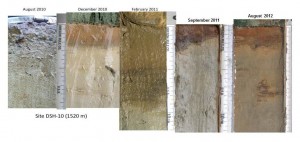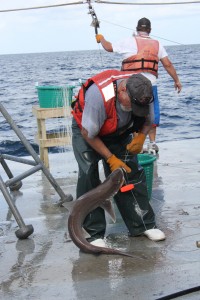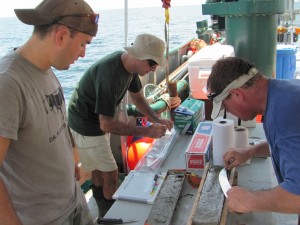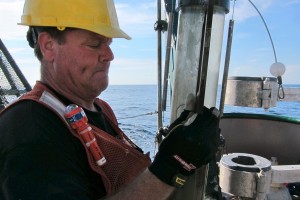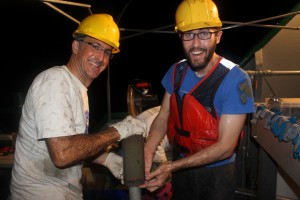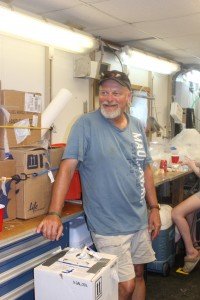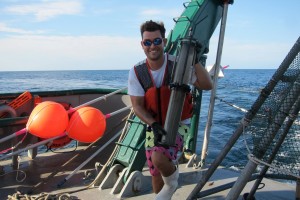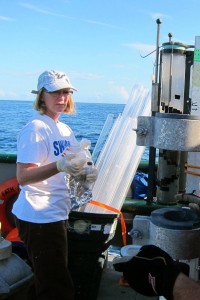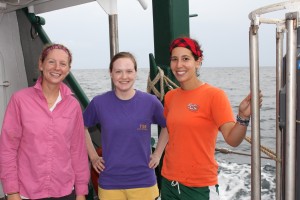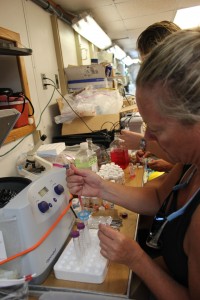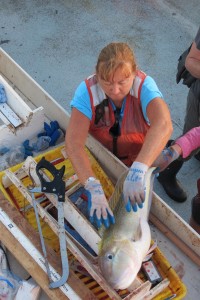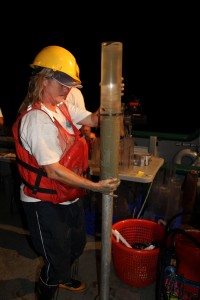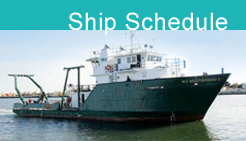Deep Sea Fish and Sediment Surveys in the Gulf
Cruise Leg 1: An Evaluation of its Success through the eyes of our Chief Scientists
By Patty Smukall
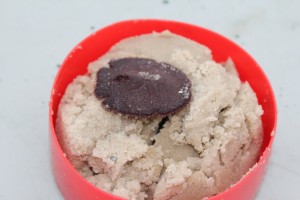
This sediment sample, complete with a living sand dollar, summarizes one the aspirations of this C-IMAGE cruise: the integration of science disciplines into a comprehensive study of the effects of contaminants on the geological, chemical and biological environment
As we were preparing to end our cruise, we interviewed both of the Chief Researchers, Dr. Steve Murawski and Dr. David Hollander and asked them for their closing thoughts on Leg 1 of the C-IMAGE expedition. Both expressed satisfaction with the success of the research, the extent of samples and data collected and with the collaboration between the two teams of investigators.
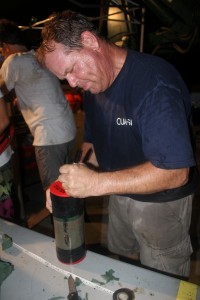
Dr. David Hollander wrapping sediment core samples before placing them in freezer for preservation. Samples will later be shared with geologists and chemists around the world.
Dr. Hollander expressed that the success of the research was due to the mutual respect and team work shown by both groups of researchers. The very efficient method of collecting fish samples during the day and core samples at night enabled them to collect more samples than expected. Most importantly, they captured the sediment/ water interface which shows the most modern conditions so scientists can correlate the modern fish conditions with modern sediment conditions to paint a more complete picture.
Dr. Hollander was ecstatic that core samples were retrieved throughout Desoto Canyon, from multiple sites ranging from 100 to over 1,500 meters deep with eight cores recovered from most sites.
Not only are USF scientists analyzing the contaminant chemistry of the pre-blowout, the blow-out event itself and the post blow-out recovery, but also C-IMAGE scientists from the Netherlands, Germany, Canada, Penn State, the University of Texas and Eckerd College to name a few.
One of the reasons for success was the flexible, adaptable nature of both Dr. Murawski and Dr. Hollander. When asked for his opinion of why this venture was so successful, Dr. Hollander sited the fact that “leadership by example” was a premier aspect of this cruise. He expressed that having Dr. Jaqueline Dixon, the Dean of the College of Marine Science, aboard and her willingness to pitch in wherever and whenever needed, set the tone for the kind of collaboration and mutual respect all participants have for each other.
Dr. Steve Murawski expressed that on this cruise, they were able to demonstrate that they can integrate vastly different technologies on the same ship to get samples, showing that they can design more cruises like this one. Another advantage of this integration of science disciplines is in getting different scientists such as chemists, geologists and biologists, together enables them to discuss what they are observing, what kinds of experiments they want to do, and analysis of data. It is not just about the sharing of samples, but the sharing of ideas that proves beneficial to all.

Dr. Murawski examining a deep water fish and removing tissue samples to be shared with other toxicology researchers.
Dr. Murawski stated that by looking at the core samples, his team will be able to prioritize some of the fish samples they will analyze to see if they might detect some of the contaminants found in the sediment samples. In the next leg of the cruise (Leg 2), they will start exploring southwest of the oil blowout, an area not yet explored in detail. He is looking forward to the chance to go to the Mississippi Valley and Gulfport, which are very important sites to explore. On the biological side are the objectives of trying to understand how the oil may have impacted animals that live on the bottom.
Both Dr. Hollander and Dr. Murawski agree that the goals and aspirations of the C-IMAGE Project, which is to explore the interaction of the chemical fate of the contaminants in the system and their biological impacts on the ecosystem are obtainable when scientists work as collaboratively and efficiently as was exemplified on this cruise.
| Print article | This entry was posted by greely on September 4, 2012 at 4:45 am, and is filed under Oceanic Updates. Follow any responses to this post through RSS 2.0. You can leave a response or trackback from your own site. |
